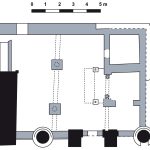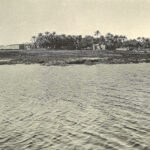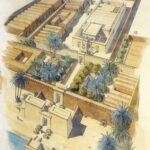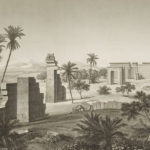MAʿBAD HĪBIS (HIBIS)
| Arabic | معبد هيبس |
| DEChriM ID | 3 |
| Trismegistos GeoID | 2786 |
| Pleiades ID | 776181 | PAThs ID | 185 |
| Ancient name | Hibis |
| Modern name | Maʿbad Hībis |
| Latitude | 25.476681 |
| Longitude | 30.555384 |
| Date from | 330 |
| Date to | 380 |
| Typology | City |
| Dating criteria | Essentially coinage (Winlock 1941: 48-49 and Appendix 1, 51-55). Winclock dates the construction of the church in the first half of the 4th century (Winlock 1941: 48), which is contested by Cipriano, who prefers a date under the reign of Theodosius I (379-395) or that of Theodosius II (402-450) (Cipriano 2008: 95). Based on the dating of the other churches in Kharga Oasis, we believe that a date between 330 and 380 is highly likely. |
| Description | The Hibis temple is situated in what was the administrative center of Oasis Magna in antiquity. The construction is understood to have commenced in 510BC, during the reign of Darius I, and was dedicated to Amūn (Winlock, 1941: 4). Winlock believes it was not the first temple dedicated to Amūn, however, with numerous sandstone blocks appearing to derive from another temple, including sections of sculpted scenes. This is in addition to the fact that the temple itself was built atop of another structure, which appears to have been razed to allow for the current temple’s construction. While the temple itself is a unique architectural example representing the transition from the architecture of the Theban Empire to that of the Ptolemaic period, our interest lies in the church which was erected against the portico of the temple sometime in the mid-fourth century, with the temple being decommissioned no later than the time of Constantine (Ghica, 2012: 195). The church has a basilical plan, typical of fourth century ecclesiastical architecture of the oases. The entrance is on the north side, however, which is an exception among contemporary churches in Kharga, and appears to simply be the result of the installation of the church against the north side of the portico (Ghica, 2012: 197). A second door could have potentially been fitted in the south wall. A baptistery is situated in the northwest corner, and appears to have been a later addition (Winlock, 1941: 46). Steps lead up to the sanctuary, with the two top-most having sockets in them for the upright end posts of the wooden screen which veiled the altar within (Winlock, 1941: 46). The fourth century date is well-supported (Winlock 1941, 48-49 and Appendix 1, 51-55 for coinage), and relates to settlement areas surrounding the temple on the north, west and south sides, as well as occupation of ʿAyn al-Ṭurba. |
| Archaeological research | Many European travelers visited the temple and left graffiti as personal testimonies. This includes Cailliaud in 1818, Drovetti and Rosingana, Hoghton, and Hyde in 1819, Letorzec and Abouchanape in 1829, Muller in 1824, Ayme and Catherwood in 1832, Carrera in 1833, Mathieu in 1835, P. W. Guy in 1843, R. H. Borrowes in 1851, Schweinfurth in 1874 and the Rohlsche Expedition in 1874. The site was also visited by Wilkinson in 1825, Hoskins in 1832 and Brugsh in 1875, none of whom left graffiti (Winlock, 1941: 59-60). Despite the notoriety of the site, the archaeological work conducted has been of a limited scope. The Metropolitan Museum of Art (MMA) only excavated briefly, commencing in 1909 and finishing in 1913. This was accompanied by numerous visits in the following years focusing on copying the reliefs, drawing up plans and photographing the site. The MMA completely ceased all forms of fieldwork in 1939. ʿA.ʿA.Ḫ. ʿAbd al-ʿAzīz, former director of the SCA Copto-Islamic Inspectorate in Kharga, states that the Kharga inspectorate conducted restoration work on the temple in the 90s, uncovering artefacts attesting to Christian occupation in the houses to the south of the temple, but no further information is available. |
• Bagnall, R. S. 2001. “The Camp of Hibis.” In Essays and Texts in Honor of J. David Thomas, edited by T. Gagos and R. S. Bagnall, 3-9. Oakville: American Society of Papyrologists.
• Bagnall, R. S. and G. Tallet. 2015. “Ostraka from Hibis in the Metropolitan Museum of Art and the Archaeology of the City of Hibis.” Zeitschrift für Papyrologie und Epigraphik 196: 175-198.
• Cipriano, G. 2008. El-Bagawat: Un cimitero paleocristiano nell’alto Egitto. Todi: Tau editrice.
• Davies, N. 1953. The Temple of Hibis in El Khargeh Oasis III: The Decoration. New York: Metropolitan Museum of Art.
• Evelyn White, H. G. and James H. Oliver. 1938. The Temple of Hibis in El Khargeh Oasis II: Greek Inscriptions. New York: Metropolitan Museum of Art.
• Ghica, V. 2012. “Pour une histoire du christianisme dans le désert Occidental d’Égypte.” Journal des savants 2: 189-280.
• Lythgoe, A. M. 1908. “The Egyptian Expedition.” The Metropolitan Museum of Art Bulletin 3/5: 83-86.
• Müller-Wiener, W. 1963. “Christliche Monumente im Gebiet von Hibis (El-Kharga).” Mitteilungen des Deutschen Archäoligischen Instituts Kairo 19: 121-140.
• Newel, E. T. 1941. “Appendix 1: The Coins Found in the Excavation of the Temple.” In The Temple of Hibis in el Khargeh Oasis I: The Excavations, edited by H. E. Winlock, 51-5. New York: Metropolitan Museum of Art.
• Osing, J. 1986. “Zu den Osiris-Räumen im Tempel von Hibis.” In Hommage à François Daumas, vol. 2, 511-16. Montpellier: Université Paul Valéry.
• Parsons, P. J. 1971. “The Wells of Hibis.” Journal of Egyptian Antiquities 57: 165-80.
• Schweinfurth, G. 1875. “Notizen zur Kenntniss der Oase El-Chargeh.” Mittheilungen aus Justus Perthes‘ Geographischer Anstalt 21: 384-393 and pl. 19.
• Wagner, G. 1987. Les oasis d’Égypte à l’époque grecque, romaine et byzantine d’après les documents grecs: Recherches de papyrologie et d’épigraphie grecques. Cairo: Institut français d’archéologie orientale.
• Winlock, H. E. 1941. The Temple of Hibis in El Khargeh Oasis I: The Excavations. New York: Metropolitan Museum of Art.


 Json data
Json data







